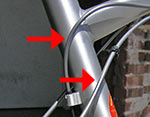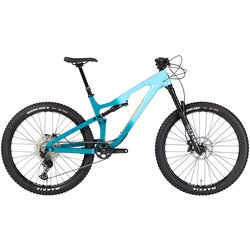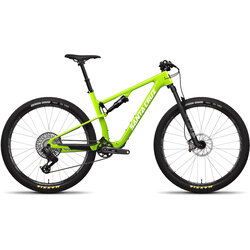Buyers' Guide To Full-Suspension Bicycles
|
|
|
Full-suspension bicycles are some of the most popular mountain bikes available today, and for good reason. The past decade has seen dramatic advances in frame and fork technology, suspension designs and rear shock function, while the overall weight of full-suspension bicycles has actually dropped to rival their hardtail siblings. In fact, the benefits of today's full-suspension rigs are so plentiful that many professional cross-country racers are winning on them. |
|
Full Suspension's Benefits
To be completely fair, there are a few negative aspects of these bicycles, including: Generally, full-sussers are more expensive and heavier than hardtails. And, more love and attention is required with them due to additional moving parts and having another shock to maintain. Most riders, however, will tell you that these are minor drawbacks considering how much more fun they have on their full-suspension rigs. We think you'll agree! |
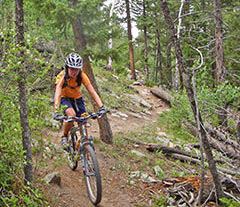 |
Bike Types To simplify, full-suspension bikes are typically listed as: short-, medium- or long-travel. Here's a description of each: |
|
Short-travel bikes (right), commonly used for cross-country riding, are some of the most common and the most similar to hardtails. They have 1 to 4 inches of travel, quicker and tighter geometry and are the lightest fully suspended rides available, generally weighing a feathery 22 to 28 pounds. Short-travel bikes excel at climbing and often feature shocks that can be locked out for the ultimate in pedaling efficiency on the road ride to the trailhead or for maximum power on smooth terrain. |
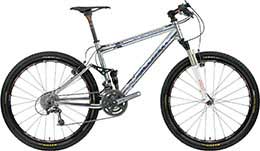 |
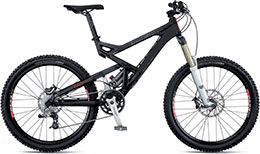 |
Medium-travel bikes (left), commonly used for all-mountain riding, have gained popularity due to their do-everything nature. They sport 4 to 6 inches of travel and often feature forks and rear shocks that have travel adjustments — making climbing easier. Plus, they boast more stable geometry — letting you go faster downhill. Medium-travel bikes are typically built with more durable components and wheels with fatter tires to tackle crazier terrain. Many riders find that medium-travel bikes are the ideal balance of lightness (26 to 34 pounds), travel and strength. |
| Long-travel bikes (right), commonly used for downhill or freeride riding, are the favorites of gravity riders. These burly rigs float on 7 to 12 inches of travel and their geometry is designed slack for high-speed stability. The components are extra strong, the tires are wide and have reinforced sidewalls and hydraulic-disc brakes with huge 8-inch rotors are the norm for maximum speed control. Many long-travel bikes utilize one chainring and a chain guide to keep the chain from falling off when you're hammering the rough stuff. |
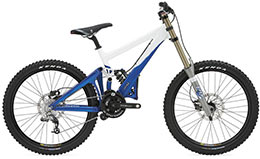 |
|
10 Great Suspension Tips & Tricks
2. Set the correct amount of sag — the amount the suspension compresses when you sit on the bike. This is an often misunderstood concept as most riders run their suspension too firm. Getting this setting right ensures that your suspension is working for you all the time and never topped out. To set it, refer to your owner's manual to find the correct setting (or visit the shock maker's website). Then, have a friend (see the left image below) hold your bike for you as you sit on it with full riding gear. Generally, the bike should sag 20 to 30 percent of its total travel. The O-ring often found on shocks (below, right) can be used as a guide for telling how much your suspension sags and for dialing in the correct amount. Or, you can simply install zip ties on your fork and/or shock and measure how far they move, too.
4. If you're riding with air shocks or forks, check your air pressure at least every 2 weeks and top it off as needed according to the manufacturer's specifications. Just like tires, air suspension will lose a little air over time. If your fork or shock needs to be pumped up daily, then you should bring it in to us to have a look at it to make sure it's not leaking. 7. Inspect the areas where your cable housings touch your frame and fork. The movement of the suspension can cause them to rub and actually cause a weak spot if allowed to persist. Install tape at the contact points (arrows, right) or stop by the shop and we can show you some frame guards and tricks to alleviate this common problem. 8. Wear and tear is greater if you ride in the mud, muck, snow, rain, etc. For these conditions you should clean your bike after every ride and check it for girt and grime that can wear shocks, bearings and other components prematurely. Cleaning is as simple as getting a bucket and sponge, filling the bucket with warm soapy water and having at it. Just be sure to never use high-pressure water to clean or rinse because it can blast the grease and oil right out of the bearings and moving parts and you definitely don't want that. Always rinse with the sponge or by dribbling water from above over your bicycle and components. Be sure to dry completely and relube after cleaning, too. 9. It's important to lube your fork and shock with only the manufacturer's recommended oils, because other types of lubes can eat through seals or harm the internals. 10. And maybe most importantly of all, if you're just getting into riding full suspension, take it easy on your first few rides on your new squishy bike. Trust us on this one. Even though it's more controlled and more fun, it's still able to be crashed. |
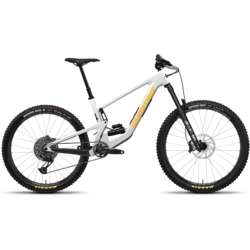
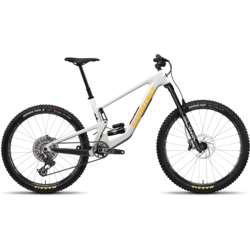


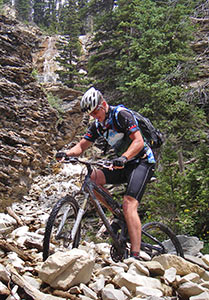 Are easier to ride. Even if you're a beginning mountain biker, you'll be able to go places you couldn't without suspension or on a hardtail. While the latter has front suspension that smoothes the ride and offers additional control, with front and rear suspension the bicycle becomes twice as easy to handle and almost any terrain is ridable.
Are easier to ride. Even if you're a beginning mountain biker, you'll be able to go places you couldn't without suspension or on a hardtail. While the latter has front suspension that smoothes the ride and offers additional control, with front and rear suspension the bicycle becomes twice as easy to handle and almost any terrain is ridable.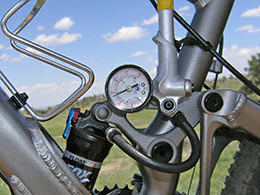 1. Adjust the air pressure or spring
1. Adjust the air pressure or spring 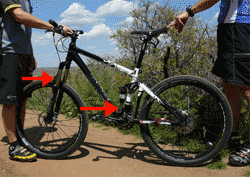
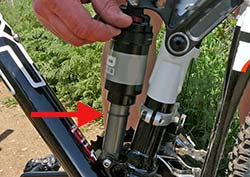
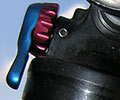
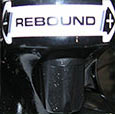 3. Dial in your
3. Dial in your 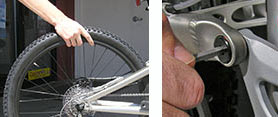
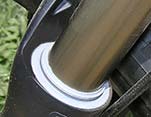 6. Be sure to wipe the
6. Be sure to wipe the 